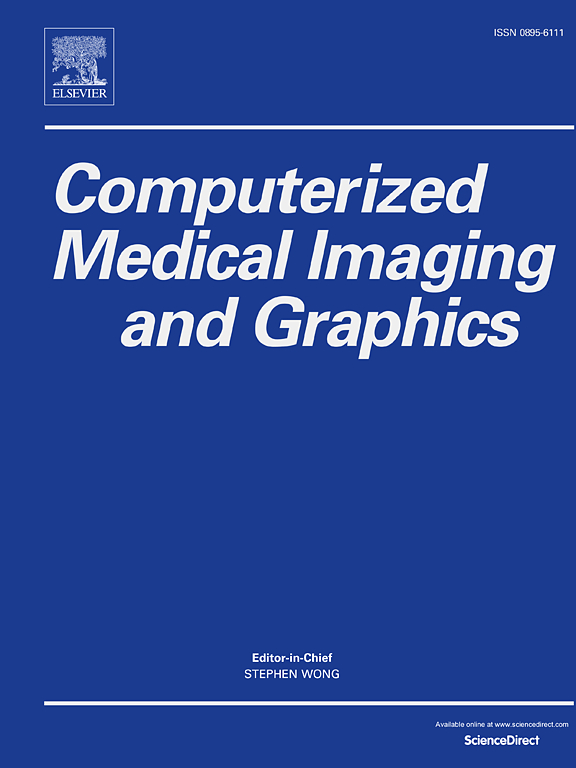基于多增强视图的主动学习,用于肺部超声图像中多种模式的分类。
IF 5.4
2区 医学
Q1 ENGINEERING, BIOMEDICAL
Computerized Medical Imaging and Graphics
Pub Date : 2024-10-24
DOI:10.1016/j.compmedimag.2024.102454
引用次数: 0
摘要
肺部超声(LUS)图像有几种主要模式,包括 A 线、B 线、合并和胸腔积液。健康肺部的 LUS 图像通常只显示 A 线,而与不同肺部疾病相关的 LUS 图像中可能会出现或同时出现其他模式。对这些主要模式进行准确分类是有效筛查肺部疾病的关键。然而,有两个挑战使分类任务变得复杂:一是由于超声成像特性,主要模式之间的固有特征差异变得模糊;二是在一个病例中可能同时存在多种模式,而临床上只对最主要的模式进行注释。为了应对这些挑战,我们提出了基于多增强视图(MEVAL)的主动学习方法,以实现更精确的 LUS 模式分类。为了突出多个模式之间的特征差异,我们通过垂直线性拟合和 k-means 聚类引入了一个特征增强模块。然后,多重增强视图与原始图像并行使用,从而增强了 MEVAL 对多种模式之间特征差异的感知。为解决模式共存问题,我们提出了一种基于置信集和错误分类集的主动学习策略。这种策略通过选择性地标记少量图像,使网络能够同时识别多种模式。我们的数据集包括 5075 幅 LUS 图像,其中约 4% 呈现出多种模式。实验结果表明,所提出的方法在分类任务中非常有效,准确率为 98.72%,AUC 为 0.9989,灵敏度为 98.76%,特异度为 98.16%,优于基于深度学习的最先进方法。一系列全面的消融研究表明,所提出的每个组件都很有效,在临床应用中显示出巨大的潜力。本文章由计算机程序翻译,如有差异,请以英文原文为准。
Active learning based on multi-enhanced views for classification of multiple patterns in lung ultrasound images
There are several main patterns in lung ultrasound (LUS) images, including A-lines, B-lines, consolidation and pleural effusion. LUS images of healthy lungs typically only exhibit A-lines, while other patterns may emerge or coexist in LUS images associated with different lung diseases. The accurate categorization of these primary patterns is pivotal for effective lung disease screening. However, two challenges complicate the classification task: the first is the inherent blurring of feature differences between main patterns due to ultrasound imaging properties; and the second is the potential coexistence of multiple patterns in a single case, with only the most dominant pattern being clinically annotated. To address these challenges, we propose the active learning based on multi-enhanced views (MEVAL) method to achieve more precise pattern classification in LUS. To accentuate feature differences between multiple patterns, we introduce a feature enhancement module by applying vertical linear fitting and k-means clustering. The multi-enhanced views are then employed in parallel with the original images, thus enhancing MEVAL’s awareness of feature differences between multiple patterns. To tackle the patterns coexistence issue, we propose an active learning strategy based on confidence sets and misclassified sets. This strategy enables the network to simultaneously recognize multiple patterns by selectively labeling of a small number of images. Our dataset comprises 5075 LUS images, with approximately 4% exhibiting multiple patterns. Experimental results showcase the effectiveness of the proposed method in the classification task, with accuracy of 98.72%, AUC of 0.9989, sensitivity of 98.76%, and specificity of 98.16%, which outperforms than the state-of-the-art deep learning-based methods. A series of comprehensive ablation studies suggest the effectiveness of each proposed component and show great potential in clinical application.
求助全文
通过发布文献求助,成功后即可免费获取论文全文。
去求助
来源期刊
CiteScore
10.70
自引率
3.50%
发文量
71
审稿时长
26 days
期刊介绍:
The purpose of the journal Computerized Medical Imaging and Graphics is to act as a source for the exchange of research results concerning algorithmic advances, development, and application of digital imaging in disease detection, diagnosis, intervention, prevention, precision medicine, and population health. Included in the journal will be articles on novel computerized imaging or visualization techniques, including artificial intelligence and machine learning, augmented reality for surgical planning and guidance, big biomedical data visualization, computer-aided diagnosis, computerized-robotic surgery, image-guided therapy, imaging scanning and reconstruction, mobile and tele-imaging, radiomics, and imaging integration and modeling with other information relevant to digital health. The types of biomedical imaging include: magnetic resonance, computed tomography, ultrasound, nuclear medicine, X-ray, microwave, optical and multi-photon microscopy, video and sensory imaging, and the convergence of biomedical images with other non-imaging datasets.

 求助内容:
求助内容: 应助结果提醒方式:
应助结果提醒方式:


